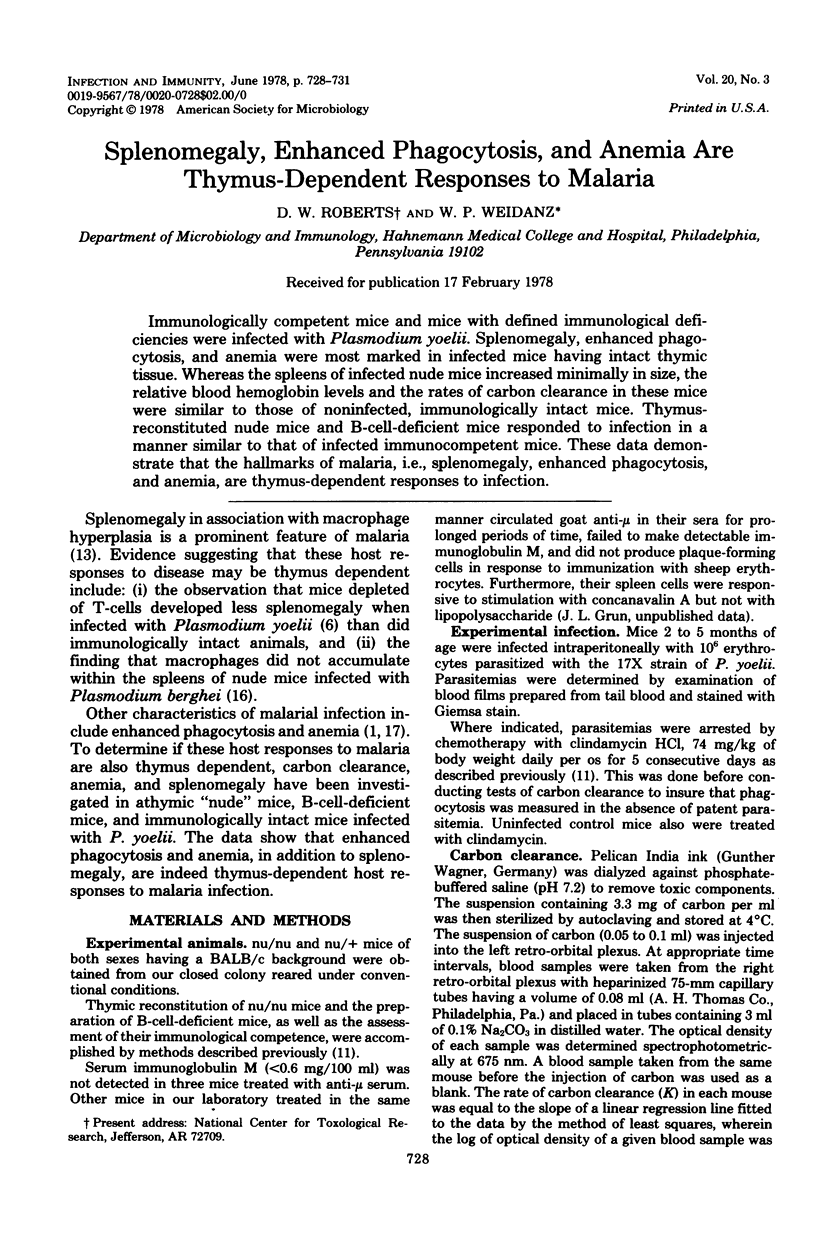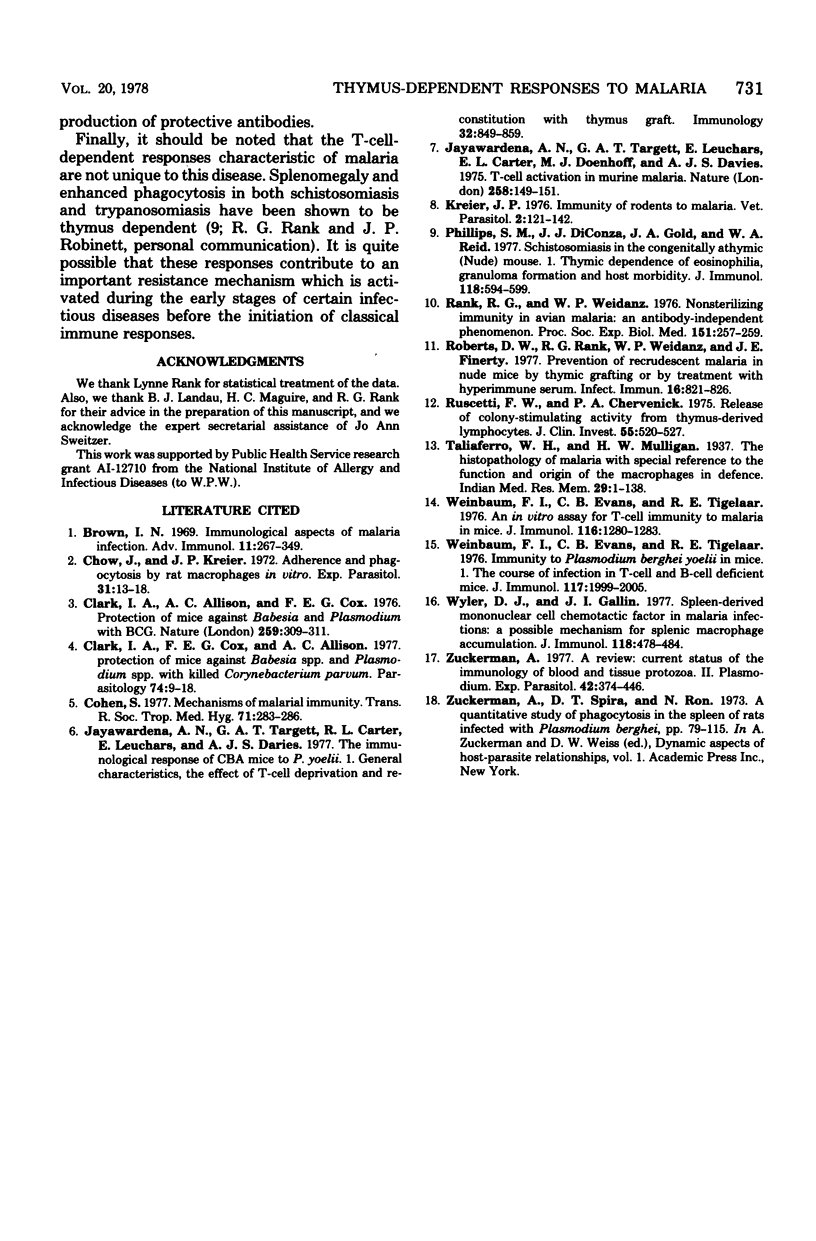Abstract
Immunologically competent mice and mice with defined immunological deficiencies were infected with Plasmodium yoelii. Splenomegaly, enhanced phagocytosis, and anemia were most marked in infected mice having intact thymic tissue. Whereas the spleens of infected nude mice increased minimally in size, the relative blood hemoglobin levels and the rates of carbon clearance in these mice were similar to those of noninfected, immunologically intact mice. Thymus-reconstituted nude mice and B-cell-deficient mice responded to infection in a manner similar to that of infected immunocompetent mice. These data demonstrate that the hallmarks of malaria, i.e., splenomegaly, enhanced phagocytosis, and anemia, are thymus-dependent responses to infection.
Full text
PDF



Selected References
These references are in PubMed. This may not be the complete list of references from this article.
- Brown I. N. Immunological aspects of malaria infection. Adv Immunol. 1969;11:267–349. doi: 10.1016/s0065-2776(08)60481-2. [DOI] [PubMed] [Google Scholar]
- Chow J. S., Kreier J. P. Plasmodium berghei: adherence and phagocytosis by rat macrophages in vitro. Exp Parasitol. 1972 Feb;31(1):13–18. doi: 10.1016/0014-4894(72)90042-2. [DOI] [PubMed] [Google Scholar]
- Clark I. A., Allison A. C., Cox F. E. Protection of mice against Babesia and Plasmodium with BCG. Nature. 1976 Jan 29;259(5541):309–311. doi: 10.1038/259309a0. [DOI] [PubMed] [Google Scholar]
- Clark I. A., Cox F. E., Allison A. C. Protection of mice against Babesia spp. and Plasmodium spp. with killed Corynebacterium parvum. Parasitology. 1977 Feb;74(1):9–18. doi: 10.1017/s003118200004748x. [DOI] [PubMed] [Google Scholar]
- Cohen S. Mechanisms of malarial immunity. Trans R Soc Trop Med Hyg. 1977;71(4):283–286. doi: 10.1016/0035-9203(77)90100-6. [DOI] [PubMed] [Google Scholar]
- Jayawardena A. N., Targett G. A., Carter R. L., Leuchars E., Davies A. J. The immunological response of CBA mice to P. yoelii. I. General characteristics, the effects of T-cell deprivation and reconstitution with thymus grafts. Immunology. 1977 Jun;32(6):849–859. [PMC free article] [PubMed] [Google Scholar]
- Jayawardena A. N., Targett G. A., Leuchars E., Carter R. L., Doenhoff M. J., Davies A. J. T-cell activation in murine malaria. Nature. 1975 Nov 13;258(5531):149–151. doi: 10.1038/258149a0. [DOI] [PubMed] [Google Scholar]
- Phillips S. M., DiConza J. J., Gold J. A., Reid W. A. Schistosomiasis in the congenitally athymic (nude) mouse. I. Thymic dependency of eosinophilia, granuloma formation, and host morbidity. J Immunol. 1977 Feb;118(2):594–599. [PubMed] [Google Scholar]
- Rank R. G., Weidanz W. P., Bondi A. Nonsterilizing immunity in avian malaria: an antibody-independent phenomenon. Proc Soc Exp Biol Med. 1976 Feb;151(2):257–259. doi: 10.3181/00379727-151-39186. [DOI] [PubMed] [Google Scholar]
- Roberts D. W., Rank R. G., Weidanz W. P., Finerty J. F. Prevention of recrudescent malaria in nude mice by thymic grafting or by treatment with hyperimmune serum. Infect Immun. 1977 Jun;16(3):821–826. doi: 10.1128/iai.16.3.821-826.1977. [DOI] [PMC free article] [PubMed] [Google Scholar]
- Ruscetti F. W., Chervenick P. A. Release of colony-stimulating activity from thymus-derived lymphocytes. J Clin Invest. 1975 Mar;55(3):520–527. doi: 10.1172/JCI107958. [DOI] [PMC free article] [PubMed] [Google Scholar]
- Weinbaum F. I., Evans C. B., Tigelaar R. E. An in vitro assay for T cell immunity to malaria in mice. J Immunol. 1976 May;116(5):1280–1283. [PubMed] [Google Scholar]
- Weinbaum F. I., Evans C. B., Tigelaar R. E. Immunity to Plasmodium Berghei yoelii in mice. I. The course of infection in T cell and B cell deficient mice. J Immunol. 1976 Nov;117(5 PT2):1999–2005. [PubMed] [Google Scholar]
- Wyler D. J., Gallin J. I. Spleen-derived mononuclear cell chemotactic factor in malaria infections: a possible mechanism for splenic macrophage accumulation. J Immunol. 1977 Feb;118(2):478–484. [PubMed] [Google Scholar]
- Zuckerman A. Current status of the immunology of blood and tissue protozoa. II. Plasmodium. Exp Parasitol. 1977 Aug;42(2):473–446. doi: 10.1016/0014-4894(77)90095-9. [DOI] [PubMed] [Google Scholar]


